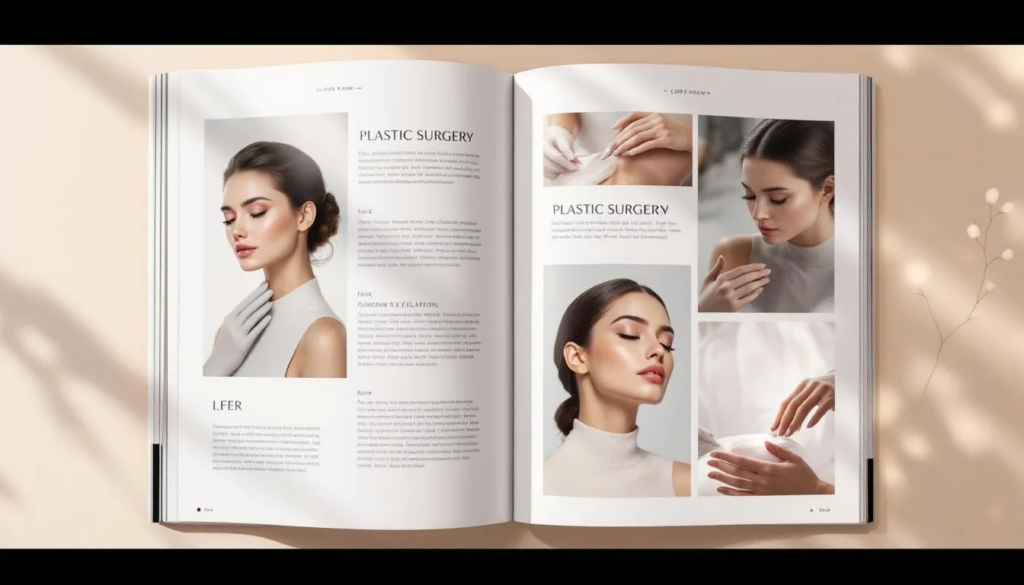Is Botox considered plastic surgery? The short answer is no; however, it is important to note that IS BOTOX PLASTIC SURGERY? Botox is a non-surgical cosmetic procedure. This article will explain the key differences between Botox and plastic surgery, helping you understand where Botox fits within the broader landscape of cosmetic treatments. Read on to learn more about how Botox works, its benefits, and how it compares to surgical options.
Key Takeaways
- Plastic surgery focuses on repairing and reconstructing body parts affected by trauma or anomalies, while cosmetic surgery aims purely at enhancing appearance.
- Botox is a non-surgical cosmetic treatment that reduces wrinkles by temporarily blocking nerve signals, requiring repeat treatments every 3-4 months for continued results.
- Choosing a board-certified provider for Botox treatments is crucial, as they have the necessary training to ensure safety and effectiveness, distinguishing them from less qualified practitioners.
What Is Plastic Surgery?

Plastic surgery is a diverse medical specialty focused on repairing and reconstructing various body parts affected by anomalies or trauma. This field goes beyond mere cosmetic enhancements, addressing a range of conditions from congenital defects to traumatic injuries and cancer-related deformities. The primary goal is to restore both form and function to the affected areas, which often requires creative and innovative techniques.
Plastic surgeons typically undergo extensive training, including five years of general surgery followed by two to three years of a plastic surgery fellowship, or six to eight years of integrated residency. This rigorous training ensures they are well-equipped to handle complex reconstructive tasks. Moreover, plastic surgeons often collaborate with other medical specialties to provide comprehensive care for their patients.
The practice of plastic surgery is not limited to any specific body part; it encompasses everything from facial reconstruction to breast augmentation and limb salvage. Each procedure is meticulously planned and executed to achieve the best possible outcome for the patient, both aesthetically and functionally. This holistic approach sets plastic surgery apart as a field dedicated to enhancing quality of life through medical and surgical interventions.
Defining Cosmetic Surgery
While plastic surgery encompasses a wide range of reconstructive procedures, cosmetic surgery focuses solely on enhancing appearance. Unlike reconstructive surgery, which aims to restore function and appearance, cosmetic surgery is purely aesthetic and does not address underlying health conditions. This distinction is crucial as it underscores the different motivations and outcomes associated with each type of surgery.
Patients often seek cosmetic surgery to improve their self-esteem and confidence regarding their appearance. Procedures such as facelift, rhinoplasty, and liposuction in cosmetic form are common examples aimed at refining and enhancing the body’s existing anatomy. The goal is to achieve a more balanced and harmonious look, tailored to the patient’s desires and expectations.
Cosmetic surgery demands a high level of expertise and precision. Board-certified plastic surgeons and cosmetic surgeon are trained to perform these procedures with the utmost care, ensuring both safety and satisfaction. The psychological benefits of cosmetic surgery are significant, often leading to improved self-image and overall well-being.
Botox: A Non-Surgical Cosmetic Procedure

Botox is one of the leading non-invasive treatments for rejuvenating the appearance of the face. Unlike surgical procedures, Botox involves minimal downtime and has become a popular choice for those looking to reduce facial wrinkles and fine lines. Botox treatments are categorized under cosmetic procedures, fitting into the broader realm of cosmetic surgery.
The primary mechanism of Botox involves the use of botulinum toxin to block nerve signals to the muscles, preventing them from contracting and thereby reducing the appearance of wrinkles. Common areas treated with Botox include forehead creases, frown lines between the eyebrows, and crow’s feet around the eyes. The procedure is quick, typically taking only a few minutes, and does not require anesthesia.
Patients often need to undergo Botox injections every three to four months to maintain their results. The cost of Botox can vary based on the number of units required, with the per-unit cost starting around $13. This cumulative expense can add up over time, but many find the immediate results and minimal recovery time worth the investment.
Botox offers a minimally invasive treatment option that provides noticeable results within days, making it a preferred choice for those seeking quick and effective facial rejuvenation. Whether it’s smoothing out crow’s feet or reducing frown lines, Botox has become a staple in the world of cosmetic enhancements.
How Botox Works
Botox injections utilize a purified form of botulinum toxin to block nerve signals that cause muscle paralysis and contract. This temporary relaxation of targeted muscles effectively reduces the appearance of wrinkles and fine lines. This mechanism is particularly effective for treating dynamic wrinkles, which are caused by repetitive muscle movements and the injection of botox.
Common areas for Botox treatment include the forehead, between the eyebrows, and around the eyes. These are regions where facial muscles are frequently engaged, leading to the formation of frown lines and smooth crow’s feet. For example, these areas can be treated interchangeably due to repeated muscle contractions.
The effects of a typical Botox session can last several months, offering a non-surgical approach to achieving a more youthful appearance.
Comparing Botox to Surgical Procedures

When comparing Botox to surgical cosmetic procedures, several key differences stand out. Botox effects typically last between three to four months, requiring repeat treatments to maintain the desired look. In contrast, surgical procedures, such as facelifts or rhinoplasty, involve higher upfront costs but often provide permanent results.
One of the main advantages of Botox is its minimal recovery time. Patients can often resume their daily activities immediately after treatment, experiencing visible results within one to three days. Surgical procedures, on the other hand, require a more extended recovery period and carry a higher risk of complications.
While Botox offers a quick and effective solution for reducing wrinkles, it does not address underlying structural issues. Surgical interventions can reshape and enhance the body’s anatomy, providing long-term benefits that Botox cannot achieve. Understanding this difference is crucial for patients when deciding which option best suits their needs.
The Role of Board-Certified Professionals in Botox Administration
Choosing a board-certified provider significantly enhances the safety and effectiveness of Botox injections. Providers certified by the American Board of Plastic Surgery or the American Board of Dermatology have undergone extensive training, ensuring they possess the necessary expertise for safe Botox administration. This certification process includes rigorous residency training and examinations, which are crucial for managing potential complications.
A thorough evaluation of health conditions and risk factors is typically conducted by the surgeon before treatment, including any necessary surgical procedure. During the consultation, the surgeon will explain the recommended treatment options and expected outcomes, ensuring patients are well-informed. This level of care and attention to details sets board-certified professionals apart from those without proper medical training, including referred dr professionals.
Patients should prioritize medical credentials over superficial certifications when selecting a Botox provider. Asking questions and addressing any concerns during the consultation can help patients feel more confident and secure in their choice of provider.
Emerging Trends: Stem Cells and Anti-Aging Treatments
Regenerative medicine is advancing rapidly, with innovative methods like stem cell therapy gaining popularity for their anti-aging properties. Stem cells are recognized for their regenerative properties in healing and mending damage from injuries in muscle, cartilage, and nerves. In the realm of cosmetic procedures, stem cells can rejuvenate and repair skin by promoting tissue regeneration.
Microneedling combined with stem cell treatments enhances skin revitalization by improving collagen synthesis and reducing signs of aging. Adipose-derived stem cells (ADSCs) have shown efficacy in improving skin texture and reducing wrinkles, offering a promising alternative to traditional cosmetic treatments.
Advancements in 3D bioprinting are facilitating the development of engineered skin substitute, which can deliver stem cells and growth factors directly to damaged areas. These emerging trends highlight the potential of stem cells and regenerative medicine in providing minimally invasive treatment options for those seeking younger, healthier skin, while also considering the role of bacteria in skin health.
Consultation and Safety Considerations
Quality Botox providers conduct thorough consultations and develop personalized treatment plans to enhance patient safety. Patients should schedule a consultation with a board-certified plastic surgeon or dermatologist before considering Botox or dermal fillers. This initial visit allows the provider to evaluate the patient’s health conditions and discuss any potential risks.
Medispas may not always have a physician on-site during procedures, impacting the level of medical oversight available. Patients should prioritize medical credentials over superficial certifications when selecting a Botox provider. Understanding the importance of proper medical training can help patients avoid confusion and ensure a safer treatment experience.
Botox was initially developed for medical uses in the 1980s and has since become widely recognized for its cosmetic applications. Discussing the patient’s goals and expectations during the consultation can help tailor the treatment plan to achieve the best possible results.
Cost Comparison: Botox vs. Plastic Surgery

Botox treatments generally range from $500 to $600 per session, with the cost varying based on the number of units required. This makes Botox a more affordable option for those seeking immediate results compared to the higher upfront costs associated with plastic surgery. However, the temporary nature of Botox means that repeated treatments are necessary to maintain the desired look.
In contrast, plastic surgery results are often permanent, addressing underlying structural issues and providing long-term benefits. While surgical procedures involve a more extensive recovery process and potential complications, they eliminate the need for frequent follow-ups. This trade-off between cost and longevity is a crucial factor for patients to consider when choosing between Botox and surgical options.
Botox offers a minimally invasive option for cosmetic enhancement, allowing for quicker procedures and reduced recovery time compared to surgical alternatives. Patients seeking cosmetic results with less risk and downtime may find Botox to be a more appealing choice.
Summary
Understanding the differences between Botox and plastic surgery is essential for making an informed decision about cosmetic enhancements. While Botox offers a quick, non-invasive solution for reducing wrinkles, surgical procedures provide long-term benefits that address underlying structural issues. Choosing a board-certified professional, staying informed about emerging trends, and considering the cost and safety implications are crucial steps in this journey. Ultimately, the best choice depends on individual needs and goals, but with the right information, achieving a youthful, refreshed appearance is within reach.
Frequently Asked Questions
Is Botox considered plastic surgery?
Botox is not considered plastic surgery; it is a non-surgical cosmetic procedure involving injections to reduce facial wrinkles and fine lines.
How long do Botox effects last?
Botox effects generally last about three to four months before another treatment is needed.
What is the cost of Botox treatments?
Botox treatments typically cost between $500 to $600 per session, depending on the number of units needed. It’s essential to consult with a professional to get an accurate estimate tailored to your specific needs.
Why is it important to choose a board-certified professional for Botox injections?
Choosing a board-certified professional for Botox injections is crucial because they have undergone rigorous training, ensuring expertise in delivering safe and effective treatments. This reduces the risk of complications and enhances overall results.
What are the emerging trends in anti-aging treatments?
Emerging trends in anti-aging treatments encompass stem cell therapy, microneedling enhanced with stem cell applications, and innovations in 3D bioprinting for skin rejuvenation. These advancements are reshaping how we approach age-related skin concerns.
